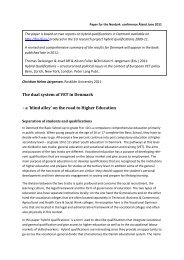Abstractbog printer - ansatte - Roskilde Universitet
Abstractbog printer - ansatte - Roskilde Universitet
Abstractbog printer - ansatte - Roskilde Universitet
You also want an ePaper? Increase the reach of your titles
YUMPU automatically turns print PDFs into web optimized ePapers that Google loves.
Abstracts - Posters<br />
P35. Is the foraging pattern of black guillemots linked to kelp forest depth<br />
distribution?<br />
Jannie Fries Linnebjerg, Susse Wegeberg & Morten Frederiksen<br />
Department of Bioscience, Aarhus University, Frederiksborgvej 399, 4000 <strong>Roskilde</strong>, Denmark.<br />
jafl@dmu.dk<br />
Black guillemots (Cepphus grylle) are well adapted to inshore benthic feeding and provide chicks<br />
with benthic fish. Although foraging areas are often associated with a rocky seabed with dense<br />
coverage of kelp reflecting the habitat preference of their prey, very little knowledge is available of<br />
the importance of kelp associated habitats for this species. A known correlation between black<br />
guillemots and their foraging habitats will be valuable in designating important and critical areas for<br />
black guillemots. Black guillemots are very difficult to census due to concealed nest sites and rare<br />
congregation in rafts on the water, and it is therefore difficult to identify the coasts with which they<br />
are associated. Thus a correlation between foraging behaviour of black guillemots and<br />
extent/density of macroalgae vegetation, as a measure for food availability, will provide a valuable<br />
indicator of important areas for nesting and foraging of black guillemot.<br />
We studied the association between black guillemot foraging and kelp forests at Kitsissut Avaliit,<br />
Southwest Greenland, by deploying time-depth recorders on black guillemots to measure the<br />
preferred dive depth, amount of time spent foraging, resting and flying. In addition, visual<br />
observations were conducted to map the foraging locations in the vicinity of the breeding sites. To<br />
map the depth extent and coverage of kelp forest, transects were conducted by ship where an<br />
underwater video recorder was used to measure the distance from the coast as well as to determine<br />
the depths limits of distinct vegetation communities, dominant species and their coverage.<br />
Preliminary analyses of the results indicate that diving tracks of black guillemot are within the<br />
depth extent of the kelp forest; average dive depth of approximately 30 m corresponds to the extent<br />
of the 100 % kelp species coverage, and max dive depth of no more than 40 m corresponds to kelp<br />
coverage of 10-50 %.<br />
The poster will present results of these studies.<br />
Program 17. danske havforskermøde, 153











